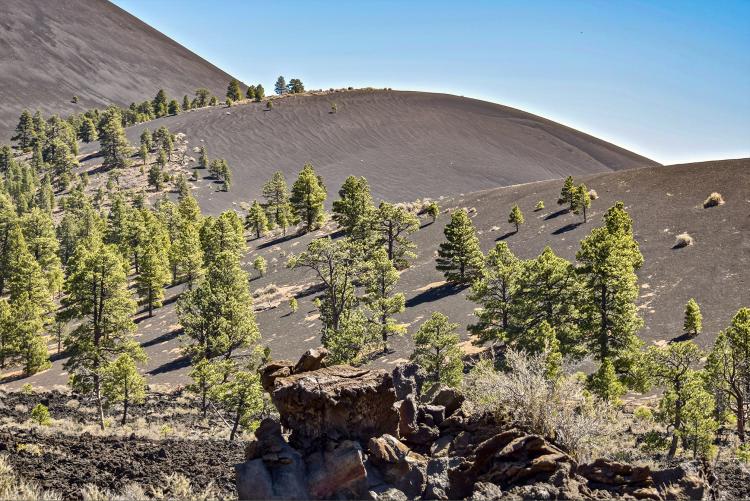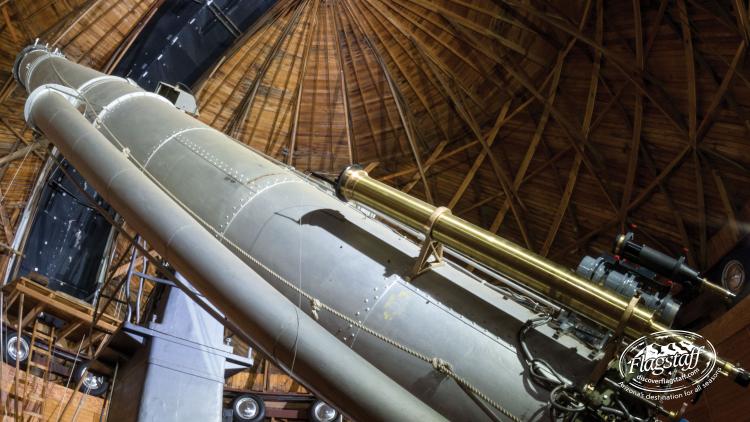3 Days Experiencing History and Culture in Flagstaff
From ancient pueblos to astronomy, Flagstaff has a long and rich history. But this is no ordinary history lesson–you’ll get to experience it all firsthand, from exploring ancient pueblos to peering through the telescope used to discover Pluto. This story was created in partnership with Visit USA Parks.
Overview
Flagstaff’s human and cultural history runs deep—over a thousand years deep. You could spend a lifetime unpacking that, but if a few days is all you have, here’s a crash course. This itinerary is meant to give you a snapshot into a wide range of historical eras, from the region’s earliest known residents to the town’s mark on space exploration.
Preparation
Situated at 7,000 feet, Flagstaff is not your typical Arizona destination—it experiences four distinct seasons, with warm summer days, cool nights, and snowy winters. Much like the rest of the Southwest, there’s a summer monsoon season that runs from June to September. That means you can expect afternoon thunderstorms to appear out of nowhere, no matter how clear and sunny it is in the morning. I recommend packing a lightweight rain jacket if you’re planning any outdoor activities. Don’t underestimate the elevation—even if you’re not doing strenuous activities, your body can lose water twice as fast here than at sea level, so stay hydrated. For driving directions in the National Monuments, don’t rely on your GPS, as they have a tendency to lead you astray (if you’re on a dirt road, you might be in the wrong place). The National Park Service websites provide detailed directions, and maps are available at the entrance stations.

Day 1: Learn about the area’s earliest inhabitants
Get an early start to spend the morning hiking some short trails in Walnut Canyon National Monument, where you’ll get to explore thousand-year-old cliff dwellings built by the Sinagua. Before you hit the trail, grab some coffee, breakfast, or baked goods on the way (Firecreek Coffee Company and Macy’s European Coffee House are two local favorites). There are two short trails at the monument; the flat, 0.7-mile Rim Trail offers views of the dwellings from above, and the slightly longer, 1 mile Island Trail. The Island Trail descends into the canyon, where you can explore 25 dwellings up close. When you’re done, head back into town where you’ll spend the afternoon at the Museum of Northern Arizona.
Housed in a sprawling, 200-acre historic campus, the Museum of Northern Arizona has a collection of over 5 million artifacts, specimens, and artworks. A new permanent exhibit, “Native Peoples of the Colorado Plateau,” tells the story of the region’s earliest inhabitants as well as the Native peoples who still live here. On top of artwork, jewelry, and artifacts, they even have a collection of dinosaur footprints.

Day 2: Sunset Crater to Wupatki
Spend the day exploring two National Monuments: Sunset Crater and Wupatki. It’s easy to spend an entire day exploring both, so plan ahead and grab a picnic lunch from Aspen Deli before leaving town.
These two monuments share a unique connection; the eruption of the Sunset Crater volcano around 1,000 years ago paved the way for the farming that would sustain the pueblos in what is now Wupatki National Monument a century later. Both monuments are accessed via a 35-mile scenic loop road, beginning off of US-89 just north of Flagstaff. You’ll pass through Sunset Crater first, where you can stretch your legs on some short hikes through the black lava fields and around the crater. If you think the landscape here is otherworldly, you’re not alone–NASA used the area in the 1960s to train Apollo astronauts.
From Sunset Crater, head north to Wupatki, taking in panoramic views of the Painted Desert along the way. Six Ancestral Puebloan archeological sites are spread out across the monument, with Wupatki Pueblo being the first you’ll encounter. Up to 100 people could live among its 100 rooms and multiple stories, complete with an above-ground kiva and ballcourt. A spur road leads to Wukoki Pueblo, one of the best-preserved structures. Perched on a sandstone outcrop, it also boasts sweeping views of the San Francisco Peaks. Keep heading north to explore the rest of the pueblos before linking back up with US-89 and returning to Flagstaff.

Day 3: From the Mother Road to the moon
Today you’ll explore the town and its more recent past. Get the retro vibes started with classic diner fare at the Downtown Diner. You’ll need to walk off those pancakes or biscuits and gravy, so take a self-guided, Route 66-themed historic walking tour downtown. Flagstaff was a major stop on America’s beloved “Mother Road,” and much of the mid-century aesthetic has been preserved. Keeping in the spirit of historic preservation, book a tour of the Riordon Mansion State Historic Park. This impeccably preserved Arts and Crafts-style home was built in 1904 by the Riordon brothers, early timber magnates drawn undoubtedly by the world’s largest Ponderosa Pine forest.
As the sun goes down, you’ll get to experience one of Flagstaff’s most famous distinctions: pitch-black skies. It was designated by the International Dark Sky Association as the world’s first Dark Sky Community in 2001, and there’s no better way to see it than at the Lowell Observatory. Pluto was first discovered here and deep space exploration has continued ever since. A number of telescopes are open to the public with general admission, giving you an up-close view of the cosmos. If you want to go deeper check out their list of ongoing camps, events, and other programs.